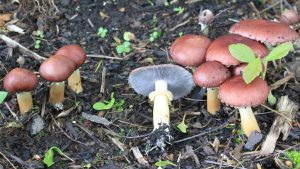#152: Amanita rubescens Group, The Blushers
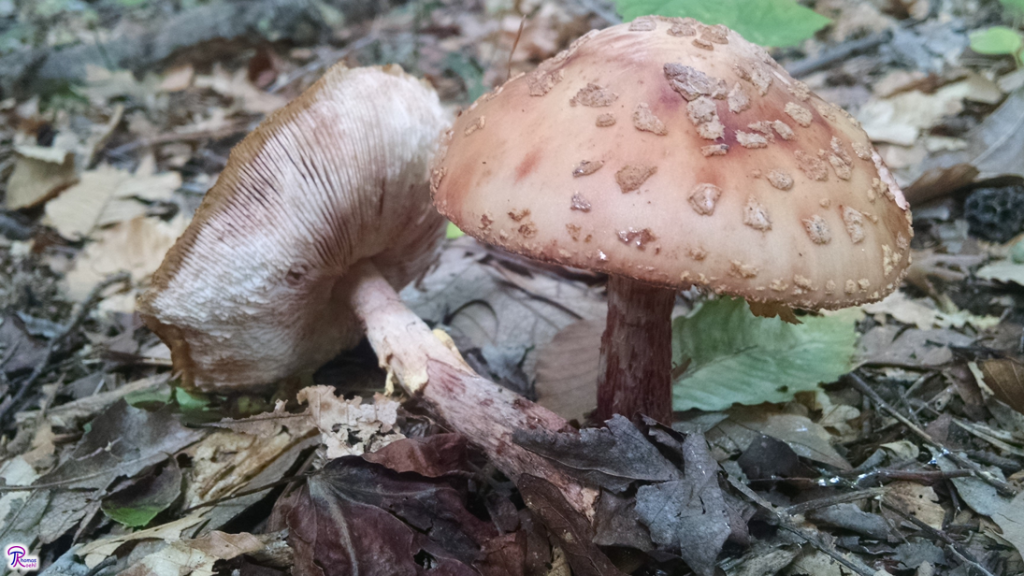
The Amanita rubescens species group includes mushrooms with a universal veil that breaks up into warts, a partial veil that leaves a ring, and that discolor reddish over time.
Amanita rubescens (and its close relatives) could be considered the fugu (pufferfish) of the mushroom world: both are edible but careless mistakes can be deadly. Although A. rubescens is considered edible and many people eat it, most people avoid the mushroom because it is easily confused with some deadly poisonous amanitas. A. rubescens slowly stains pinkish when injured, earning it the nickname “The Blusher.” Other than this distinctive staining reaction, the mushroom looks a lot like other species of Amanita; the Blusher is a tannish umbrella-shaped agaric with warts on the cap and a ring on the stalk.1–4
Description
The Blusher is a medium-sized to large mushroom with a classic umbrella shape. It grows 5-20cm tall and 4-15cm wide. The pileus is circular, displays brownish-yellow to brown colors, develops reddish tones as the mushroom ages, and is decorated by many small warts. These warts are remnants of the universal veil and easily brush off (members of the genus Amanita usually have both a universal veil and partial veil, see FFF#172). At first, the warts are yellow but they become tan, gray, or slightly pinkish as the pileus expands.1–4
Underneath the pileus, the mushroom displays gills that radiate from the central stipe. The gills are white, close together, and do not touch the stipe or just barely touch the tip of the stipe. These count as free gills, which is one of the characteristics to look for when identifying amanitas. “Short-gills” that do not run the whole radius of the pileus are formed frequently. Like all other Amanita species, the gills drop spores that leave a white spore print.1–4
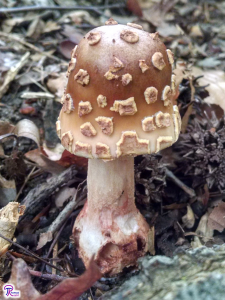
Like most Amanita species, the Blushers have two veils. In the photo above (A. amerirubescens), the yellowish universal veil is fading to tan while breaking apart to form warts on the expanding pileus.
The most prominent feature of the Blusher’s stipe is the ring. This white, skirt-like piece of tissue is all that remains of the mushroom’s partial veil. Although the ring is persistent, it is rather flimsy and sometimes breaks off, especially after you handle the mushroom. The stipe is roughly equal in thickness throughout its length (1-3cm thick), though it may be enlarged at the base. Although it is initially white, the stipe discolors pinkish red, especially where damaged. The mushroom’s base does not retain any remnants of the universal veil.1–4
One of the most important features of the Blusher is its tendency to slowly stain pinkish red (“blush”). The mushroom’s flesh is generally white, except where damage has occurred (from insect holes or your thumb/knife, for example). When exposed to air, the surfaces slowly develop a red or pinkish color. This feature helps sort out A. rubescens from many of its look-alikes.1–4 Since this happens very slowly, it may be easier to look for damage around insect holes than to wait for the color change after you damage it.
Ecology
The Blusher is mycorrhizal (it gives nutrients to trees in exchange for sugar) with oaks or pines and other conifers. Depending on your geographic region, the Blusher may prefer hardwoods, softwoods, or mixed forests. You can find it growing on the ground under these trees in the summer and fall. In warmer climates, it is also found during the winter. The mushrooms can fruit alone, in small groups, or several spread over a wide area.1,2,4
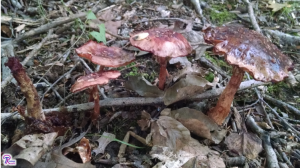
These very old Blushers (A. amerirubescens) are unusually dark red. This is probably because of their age; younger mushrooms nearby helped to confirm the identification.
The Blusher Complex
Mycologists are slowly teasing out all the species that go under the name “Blusher.” Europe’s species is well understood, but the species in the rest of the world are just beginning to be understood. America has at least four species, although there are probably more. To accurately identify your Blusher species, it is best to have some young species that are unopened or just recently opened as well as some older species that are blushing. You should pay particular attention to the color of the pileus and color of the universal veil before the mushroom starts blushing.
Europe
A. rubescens var rubescens is the official name for the European species. The easiest way to differentiate between Blushers is by the continent on which they are found. However, the European A. rubescens var. rubescens has occasionally been exported to other continents in the soil with European trees, so it can (rarely) be found elsewhere. The “Eurasian Blusher” has a brown cap with a whitish universal veil.5,6
Eastern North America
The standard North American version is found east of the Rocky Mountains and north of Mexico. Amanita expert Rob Tulloss gives this species the provisional name Amanita amerirubescens. DNA studies have shown that the North American version is a different species, but it has yet to be formally described in a mycological journal. Based on DNA evidence only, he also identifies seven cryptic species within A. amerirubescens that he is slowly sorting out. The species designated A. amerirubescens (“Eastern American Blusher”) occurs at least from Georgia to Newfoundland and west to the Mississippi. This version tends to be shorter and stouter than its European counterpart. Additionally, it has a light brownish pileus and a yellow universal veil. The partial veil is whitish but sometimes yellowish underneath.6,7
Another Eastern North American Blusher is A. rubescens var. alba (“Eastern American White Blusher”). As its name suggests, this mushroom features a white cap. Its universal veil is sometimes yellowish when young and, like A. amerirubescens, the partial veil is sometimes yellow underneath. A. rubescens var. alba appears in forests dominated by oaks and pines from South Carolina to Connecticut west to the Mississippi River.6,8
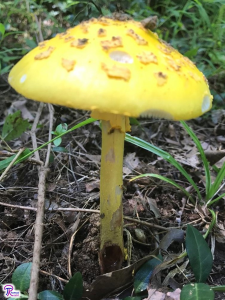
One of the Eastern North American Blushers is easily distinguished by its yellow colors: A. flavorubens (a.k.a. A. flavorubescens). This mushroom’s base features an insect hole that clearly stained reddish.
A. flavorubens (also known as A. flavorubescens; the name debate is not quite settled) is the easiest species of Blusher to identify in Eastern North America. That mushroom (called the “Yellow American Blusher”) features a yellow cap, yellow stipe, yellow universal veil, and yellowish partial veil. Bottom line: it’s yellow, whereas all the other Blushers are whitish or brownish. This mushroom appears in forests of beech, oak, pine, birch, and Canadian hemlock from southeastern Canada all the way through Mexico.6,9,10
Western North America
West of the Rocky Mountains, there is only one species of Blusher: A. novinupta (the “New Bride Blusher”). Compared to the eastern versions, A. novinupta is completely white when young, has a slightly larger base, has a slightly thicker stipe, and bruises a bit more quickly. The species grows under pines, oaks, and mixed forests from British Columbia through Arizona and Mexico. It was also introduced to Spain’s Canary Islands. A similar species appears in Norway, although that mushroom has not been properly described.6,11
Central America
In Central America, the most common Blusher is A. brunneolocularis (the “Mesoamerican Dark Volva Blusher”). This is a very dark version of the Blusher, with a tan pileus and a stipe that is covered in dark fibrils. The universal veil is greyish, making it darker than that of most Blushers. Additionally, the partial veil is unusually dark on the underside. This mushroom primarily grows in Central America, but apparently its range extends well into the United States to at least the central Appalachians.6,12
Asia
A. orsonii (“Miller’s Asian Blusher” – named for noted mycologist Orson Miller) is found in much of Asia, from Pakistan to Japan under oaks and conifers. Initially, the pileus is whitish but soon turns reddish to orange-red. The universal veil is white. When very young, it is similar to A. novinupta, but older specimens should be easy to tell apart because of A. orsonii’s brighter colors. Additionally, you shouldn’t find the two species on the same continent.6,13
Africa
In Africa, there is at least one species of Blusher: A. congolensis (no common name established). The pileus is whitish at first, the universal veil is whitish but becomes greyish, and the partial veil is also whitish but becoming greyish. The mushroom’s range is not very well defined, but it centers around Central Africa.6,14
Similar Species
The Amanita genus is full of very similar species, many of which contain deadly toxins. Bruising reddish helps separate out the Blushers from many of these species, but you must check every specimen to be sure it exhibits the proper color change. These mushrooms don’t stain readily like a lot of other mushrooms that exhibit color changes; you might have to wait a long time to see the reaction. When you collect a mushroom you think is a Blusher, scratch the stipe near the base and check for a color change when you get home.
The Blushers do have a lot of variability, which makes the species easy to misidentify. One of the mushrooms most commonly mistaken for A. rubescens is the Panther Cap, A. pantherina. This deadly mushroom does not blush and has a volval sac at its base, but displays similar coloration and ornamentation to the Blushers.2 There are some dangerous reddening amanitas in the section Amidella, but those have a volval sac and lack a ring. Additionally, the mushrooms A. daucipes and A. roseitincta are similar but have very large bases (without a volva) and a distinctly powdery texture.3
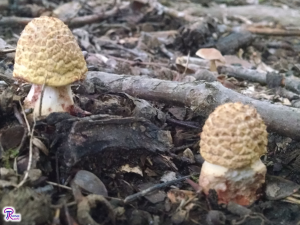
It is easiest to identify the Blushers when you have a collection of both young and old mushrooms. Cap color is difficult to assess in the buttons shown above, but even the bases of these young mushrooms are beginning to discolor around insect damage.
Edibility
A. rubescens is considered edible, but it must be thoroughly cooked. When raw, the mushroom contains a hemolytic toxin that destroys red blood cells, causing anemia. This toxin decays when heated, making the mushroom safe for human consumption.2,4 Of course, this assumes that the mushrooms have been correctly identified. Many people (probably most mushroom hunters) do not eat mushrooms from the genus Amanita because of the dire consequences of misidentification. For this reason, I recommend that you never eat an Amanita. If you wish to eat the Blusher, you should first have your specimens identified by an expert. For reference, I do not trust my identification skills enough to eat Blushers that I have identified – and certainly not enough to tell other people to eat it! Perhaps I will be confident enough five years from now.
Taxonomy
Currently, the Blushers are defined as a taxonomic group based on morphological features. This is particularly true for the Blushers found in Eastern North America: Rod Tulloss notes that all three of those species have a universal veil that is at least sometimes yellow, which suggests a very close taxonomic relationship.9 The other Blushers are also very similar macroscopically and microscopically, which so far supports keeping them in a single taxonomic group.5,7–9,11–14
However, DNA has not been kind to morphology-based taxonomy in other mushroom groups. For example, liquefying gills turn out to have evolved in two separate lineages and the genus Coprinus had to be pared down quite a bit (see FFF#177). The Blushers definitely belong to the genus Amanita (FFF#172), although their exact placement within the genus may change in the future. Fortunately, that should have little impact on the species’ binomial names (also, I’m sure Rod Tulloss has done some DNA work on these amanitas, but he doesn’t discuss that on his webpages). Of course, “A. amerirubescens” is only a provisional name and there are at least seven (probably more) unnamed Blusher species.6,7 So, be prepared to learn some new scientific names for Blushers in the future, or just use their common names and ignore the scientific kerfuffle.
The scientific name “rubescens” means “becoming red.” You might encounter the term rubescent, which is derived from the same roots and is just a fancy word for “blushing.”
| Kingdom | Fungi |
| Subkingdom | Dikarya |
| Division (Phylum) | Basidiomycota |
| Subdivision (Subphylum) | Agaricomycotina |
| Class | Agaricomycetes |
| Subclass | Agaricomycetidae |
| Order | Agaricales |
| Family | Amanitaceae |
| Genus | Amanita |
| Subgenus | Lepidella |
| Section | Validae |
| Species | Amanita rubescens var. rubescens (Pers.:Fr.) Pers5
Amanita amerirubescens Tulloss7 Amanita rubescens var. alba Coker8 Amanita flavorubens (Berk. & Mont.) Sacc.9 Amanita flavorubescens G.F. Atk.15 Amanita novinupta Tulloss & J. Lindgr.11 Amanita brunneolocularis Tulloss, Ovrebo & Halling12 Amanita orsonii Ash. Kumar & T. N. Lakh.13 Amanita congolensis (Beeli) Tulloss, B. E. Wolfe, K. W. Hughes, Kudzma & Arora14 |
This post is not part of a key and therefore does not contain enough information to positively identify any mushroom. When collecting for the table, always use a local field guide to identify your mushrooms down to species. If you need a quality, free field guide to North American mushrooms, I recommend Michael Kuo’s MushroomExpert.com. Remember: when in doubt, throw it out!
See Further:
http://www.mushroomexpert.com/amanita_rubescens.html
http://www.first-nature.com/fungi/amanita-rubescens.php
http://www.mushroomthejournal.com/blushing-amanitas/
http://www.wildfooduk.com/mushroom-guides/the-blusher-mushroom/
http://www.amanitaceae.org/content/uploaded/pdf/valirube.pdf (PDF)
Detailed Information from Studies in the Amanitaceae:
http://www.amanitaceae.org/?Amanita+rubescens
http://www.amanitaceae.org/?Amanita+amerirubescens
http://www.amanitaceae.org/?Amanita+flavorubens
http://www.amanitaceae.org/?Amanita%20rubescens%20var.%20alba
http://www.amanitaceae.org/?Amanita%20novinupta
http://www.amanitaceae.org/?Amanita%20brunneolocularis
http://www.amanitaceae.org/?Amanita%20orsonii
Citations
- Kuo, M. Amanita rubescens. MushroomExpert.Com (2016). Available at: http://www.mushroomexpert.com/amanita_rubescens.html. (Accessed: 11th August 2018)
- O’Reilly, P. Amanita rubescens Pers. – Blusher. First Nature Available at: https://www.first-nature.com/fungi/amanita-rubescens.php. (Accessed: 11th August 2018)
- Blushing Amanitas. Mushroom (2014).
- Eric & Marlow. The Blusher. Wild Food UK Available at: http://www.wildfooduk.com/mushroom-guides/the-blusher-mushroom/. (Accessed: 11th August 2018)
- Tulloss, R. E. Amanita rubescens. Studies in the Amanitaceae Available at: http://www.amanitaceae.org/?Amanita+rubescens. (Accessed: 11th August 2018)
- Tulloss, R. E. Tabular Key to Rubescent Species of Amanita Section Validae. Studies in the Amanitaceae Available at: http://www.amanitaceae.org/content/uploaded/pdf/valirube.pdf. (Accessed: 11th August 2018)
- Tulloss, R. E. Amanita amerirubescens. Studies in the Amanitaceae Available at: http://www.amanitaceae.org/?Amanita+amerirubescens. (Accessed: 11th August 2018)
- Tulloss, R. E. Amanita rubescens var. alba. Studies in the Amanitaceae Available at: http://www.amanitaceae.org/?Amanita%20rubescens%20var.%20alba. (Accessed: 11th August 2018)
- Tulloss, R. E. Amanita flavorubens. Studies in the Amanitaceae Available at: http://www.amanitaceae.org/?Amanita+flavorubens. (Accessed: 11th August 2018)
- Kuo, M. Amanita flavorubescens. MushroomExpert.Com (2013). Available at: http://www.mushroomexpert.com/amanita_flavorubescens.html. (Accessed: 11th August 2018)
- Tulloss, R. E. Amanita novinupta. Studies in the Amanitaceae Available at: http://www.amanitaceae.org/?Amanita%20novinupta. (Accessed: 11th August 2018)
- Tulloss, R. E. Amanita brunneolocularis. Studies in the Amanitaceae Available at: http://www.amanitaceae.org/?Amanita%20brunneolocularis. (Accessed: 11th August 2018)
- Tulloss, R. E. Amanita orsonii. Studies in the Amanitaceae Available at: http://www.amanitaceae.org/?Amanita%20orsonii. (Accessed: 11th August 2018)
- Tulloss, R. E. Amanita congolensis. Studies in the Amanitaceae Available at: http://www.amanitaceae.org/?Amanita%20congolensis. (Accessed: 11th August 2018)
- Amanita flavorubescens. Mycobank Available at: http://www.mycobank.org/Biolomics.aspx?Table=Mycobank&Rec=342002&Fields=All. (Accessed: 11th August 2018)

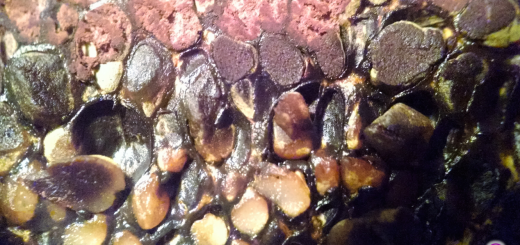






![#011: Characteristics of Kingdom Fungi [Archived]](https://www.fungusfactfriday.com/wp-content/themes/hueman/assets/front/img/thumb-small-empty.png)

